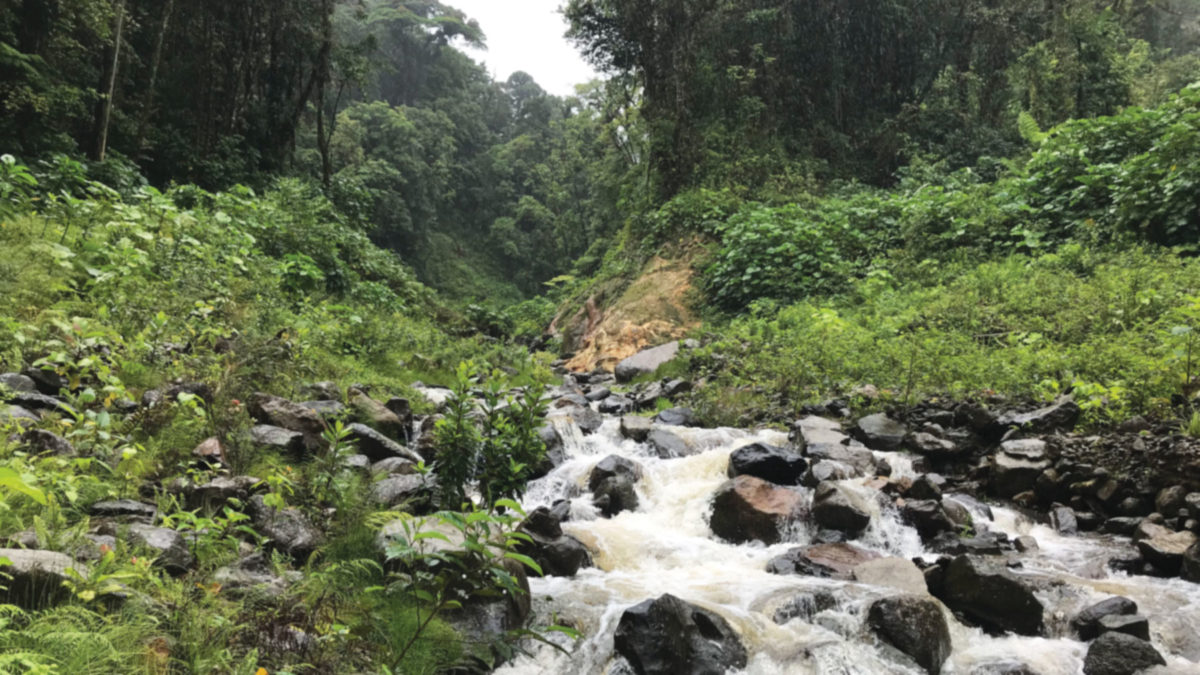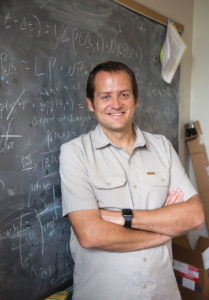Mathematical Nature and Natural Math
Brian Yurk, Ph.D. | Associate Professor of Mathematics
On a table in his office in VanderWerf Hall, a popular recent memoir about hiking the Appalachian Trail sits alongside Dr. Brian Yurk’s mathematics papers and journals. The presence of each offers empirical evidence of how the applied mathematician’s love of nature is combined with his love for his work.
He’s a backpacker, climber, skier, ultra-runner, mountain biker, canoeist and a fan of Bill Bryson’s A Walk in the Woods, and when he sees a mathematical problem in the environment, he wants to solve it. In much of his research, he applies mathematics to biology and geology: analyzing dune movement, studying animal-population patterns and handling the quantitative component of plant-succession surveys related to gaps in the Costa Rican rain forest canopy caused by wind or landslides.
Yurk has been involved in that last project for nine years with Hope colleague Dr. K. Greg Murray, the T. Elliot Weier Professor of Plant Science. In the early 1980s, Murray originated the research on gaps in the rain forest canopy near Monteverde, Costa Rica. Yurk got involved in the project when Murray sought help to unearth mathematical matrices that can explain the rates at which gaps could close due to the growth of pioneer plants below. The goal of the research is better understanding of this natural dynamic.
Murray and Yurk track the number and size of gaps, and of different pioneer plants found in those gaps along five transect lines they’ve defined in the forest, each 500 meters long. “We look only at plants that are within two meters of the transect,” Yurk explains. “We look at any new gap that crosses the transects, too. There are actually ropes that Greg has out there and then replaces every few years.”
Employing those data, Yurk uses linear algebra to create a matrix model that extrapolates plant growth and reproduction and mortality rates to forecast future population dynamics. “The mathematical theory allows us to make predictions based on the characteristics of this matrix as to what the long-term distribution should be,” says Yurk.
The variables are many: sun exposure, air temperature, seed banks, soil nutrients and more. So the project’s complexity is ample, too. But asking and attempting to answer fundamental questions about how the rain forest works when gaps emerge is a driving force that keeps Murray and Yurk interested after all this time. In no way do they intervene in the forest’s growth, nor are they advocating for intervention. In fact, for a number of the areas they study, the more slowly the gaps close, the better it is for the plants and the animals who live in them.
“Those plants are important sources of food, particularly for birds and bats,” Yurk says. “And as such, they’re an important part of the food supply for every animal in the food chain in the rain forest. That’s why it’s important to understand what’s going on with and in these gaps.”
While the Hope duo has gathered data on site in the same five transects for a number of summers, Yurk is looking to expand their reach. He received a Michigan Space Grant in 2019 to use satellite imagery to identify gaps. “Instead of just working along these five lines, now we can work over the entire forest area,” he exclaims. “Then we’ll have more gaps that we can analyze and we can do a lot of it remotely.”
Yurk used the summer of 2019 to test his satellite concept by writing a computer program that automatically identifies canopy gaps in high-resolution imagery. First, he scoured satellite images for gaps with his own eyes; then he trained a computer algorithm to pick out the gaps that his human eyes saw. “The big remaining questions were these: If I’m identifying those things correctly visually, is the algorithm picking out the same gaps, too? Is there actually a gap there in the forest? On the other side of that, if the algorithm doesn’t identify a gap, is that right as well?”
Then he put it to the test in Costa Rica by hiking into 100 extremely remote locations, 50 of which had been identified by the algorithm as a gap and 50 of which had not. The results were encouraging. Of the 50 gaps that the algorithm picked out from the satellite imagery, he was able to confirm 47 visually from the ground. And of the 50 areas that the algorithm identified as not having gaps, at 47 of them he spotted no evidence of gaps as he gazed upfrom the rain forest floor. “So, what the algorithm was picking out was matching my visual identification, which was matching up in the field with a fairly high degree of accuracy,” he says.
Through every environmental and mathematical project, Yurk’s desire to study the natural world mathematically has interacted with his Christian views. “To understand creation — that’s always been an important part of how I think about my work,” he says.
In the coming years, with plenty of rain forest gaps to study and explore, Yurk will undoubtedly be able to think about math, nature and faith even more.













One thought on “Mathematical Nature and Natural Math”
Comments are closed.